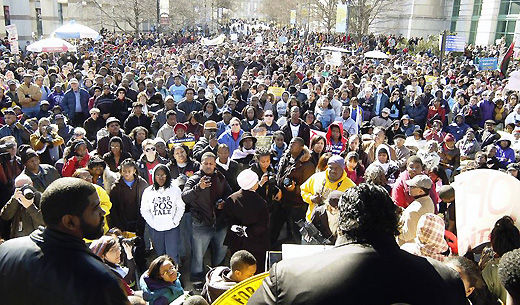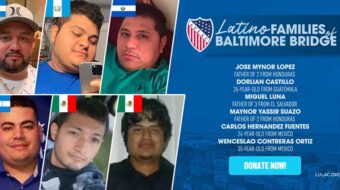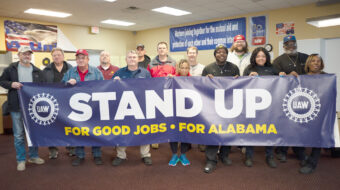
RALEIGH, N.C. – Thousands poured out for the seventh annual HKonJ – Historic Thousands of Jones Street – rally here Feb 9, under the theme “Forward Together, Not One Step Back … Mobilizing for Economic Justice and an End to Poverty.”
Spearheaded by the state chapter of the NAACP, HKonJ includes more than 140 multiracial social justice groups.
Stepping off at Shaw University, a historically black college, thousands marched to the Legislative Building on Jones Street. There they heard several speakers, including Chairman of the NAACP National Board of Directors Roslyn M. Brock and state NAACP President Rev. William Barber, discuss a five-point agenda that emphasizes education, the economy and the criminal justice system.
Coalition members are concerned about attempts by the Republican legislature to pass a voter identification bill. And a measure that cuts jobless benefits could reach Gov. Pat McCrory’s desk next week.
“In the face of our progressive agenda, we’ve seen a new ultra-conservative, Republican-led leadership unleash a cruel and unusual attack on labor rights, unemployment rights, Medicaid and voting rights,” Barber said. “It will have a devastating impact on the poor and working people.”
The NAACP state chapter in January urged North Carolina lawmakers to focus on issues surrounding poverty and economic justice.
The state’s poverty rate is 12th highest in the U.S., with one of every four children living in poverty. The rate is much higher for black and Latino children.
The NAACP says “1.7 million North Carolinians live in poverty” – about the same number as in 1968.
“The gap between the rich and poor is wider than it was during the Great Depression,” Barber said. “There are 700,000 in deep poverty, 600,000 children. There are 10 counties where the poverty rate has been over 20 percent for more than 30 years.”
North Carolina’s poverty rate was 17.9 percent in 2011, unchanged from the rate in 2010. The poverty rate jumped more than 25 percent since 2007, the beginning of the Great Recession.
– Nearly 1.7 million North Carolinians were officially in poverty in 2011, and more than 737,000 lived in deep poverty.
– The poverty rate for children in North Carolina was 25.6 percent in 2011, compared to 9.7 percent for seniors.
– People of color experienced higher rates of poverty. In 2011, 28 percent of African Americans, 34.9 percent of Latinos, and 27 percent of American Indians in the state lived in poverty.
– Median household income fell to $43,916 in 2011, down 1.8 percent from $44,726 in 2010.
Many North Carolinians believe that, when we see a poverty rate for children in the state as high as 25.6 percent, we must keep in mind that these children are not white, black, brown or red children; they are God’s children and our children, and we have to do right by them.
Even though progressives had a setback here in North Carolina in last fall’s election, it has invigorated the forces of progress and the building of strong people’s coalitions, as evidenced by Sunday’s rally.
Photo: 15,000 people gather for the sixth annual Historic Thousands on Jones St. people’s assembly in Raleigh, N.C., Feb. 11, 2011. hkonj.com

MOST POPULAR TODAY


Zionist organizations leading campaign to stop ceasefire resolutions in D.C. area

Communist Karol Cariola elected president of Chile’s legislature

Afghanistan’s socialist years: The promising future killed off by U.S. imperialism

High Court essentially bans demonstrations, freedom of assembly in Deep South






Comments